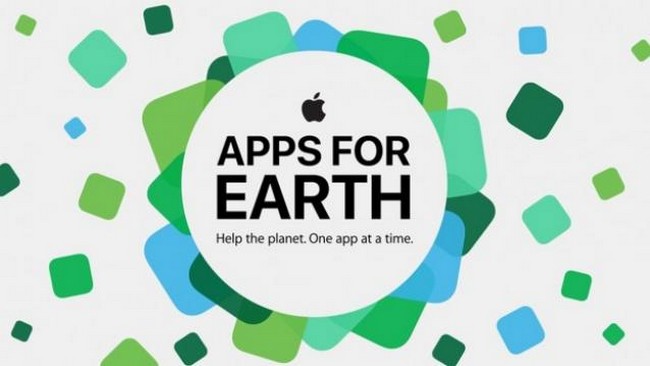
Apple is making a big splash with its Apps for Earth initiative, devoting some of its sales and app content to green issues. But can environmentally themed Candy Crush seriously engage people in these issues? Is it a PR stunt or meaningful philanthropy? Here’s a critical look at what Apple’s up to with its latest corporate responsibility move.
When I first heard about Apple’s big Earth Day-timed environmental campaign, I have to admit I was pretty skeptical. And I’m not one of those Apple haters—I actually learned about the extent of the program while at an Apple store, buying a long overdue new MacBook, on which I’m writing this.
I had heard a little about the initiative, and then I walked into the sterile, tech consumer’s paradise to find the small army of employees wearing green shirts instead of the usual blue. The little leaf on the Apple logo had turned green, and the screens were playing a video of a robot dismantling iPhones for recycling. I immediately got that faint uneasiness that environmentalists tend to experience regarding corporate gestures in the name of saving the planet—an involuntary response to the fumes of freshly applied green paint.
Green shirts aside, this latest program does have some substance to it, and it’s certainly a new approach to giving. During a 10-day window happening now, the sales and in-app purchases for 27 popular apps will go to the World Wildlife Fund. Developers of the participating apps have incorporated environmentally themed content to raise awareness about the importance of environmental issues. The idea is to raise money for the WWF and engage millions of people about the need to protect the planet.
I still have my doubts about whether this creative use of iPhone apps is the best vehicle for both philanthropy and public engagement. But overall, Apple is moving in a good direction, and one important layer to this promotion—especially in the context of Apple’s history and its emerging platform of environmental initiatives—is the way it merges its developing corporate conscience with its public brand. In other words, yeah, it is kind of a marketing stunt, but not a bad one.
When it comes to the financial impact of Apps for Earth, it’s hard to say at this point just how much we’re talking about, but it feels underwhelming in the context of the company’s sheer size and power—sales from 27 apps for 10 days relative to, well, everything else that the biggest company in the world owns and earns.
To be clear, it might not actually be small in terms of environmental nonprofit fundraising, and WWF is a perfectly worthy group to support. I have no clue how much money those 27 apps will make in 10 days. Maybe it will be a truly massive amount, and I will possibly feel silly for dismissing it.
But even if that is the case, it would just highlight the insane amount generated by products like Angry Birds and Cut the Rope in a mere 10 days. For perspective, Apple and Alphabet (Google) are competing these days for the world’s most valuable company, with Apple currently worth around $600 billion in market value, and breaking records for corporate profits. Annual total revenue in FY 2015 was nearly $234 billion. The App Store is actually a pretty small part of that, with one estimate of Apple’s 30 percent cut of all app sales at $6 billion in 2015.
So regardless of how much Apps for Earth ends up raising, in the context of the company’s earnings, it’s a drop in a big bucket.
Of course, the reason for tying the promotion to the App Store is more about involving the public. Much of the praise the program has received is about the millions of people it will reach. As Lisa Jackson, VP of Environment, Policy and Social Initiatives at Apple, wrote in her Medium post about the campaign: “With Apps for Earth, we’re helping to inform, engage and involve millions of people in global environmental efforts through the fitness, education, entertainment and gaming apps they use every day.”
Will these apps and in-app purchases really engage the public in a meaningful way? One of the promoted apps is a World Wildlife Fund product with some pretty cool interactive content. Games like SimCity and The Earth are suited for folding in big environmental concepts.
But most of the content, judging from the iTunes descriptions, is pretty superficial stuff. In Cut the Rope, the main character will be replaced by a panda. In Hearthstone: Heroes of Warcraft, you can add a “Khadgar” mage card to your—OK, I have no idea what any of that means. A Star Wars game offers a level in the forests of Endor. In Kendall & Kylie you can buy clothes and stickers themed around the environment.
I’m not trying to beat up on these developers. But if the argument for this promotion is to engage the public, I question whether the majority of phone apps are viable platforms to inspire action. At the App Store page pitching the promotion, the intro text reads: “Our planet needs you. Your part is easy—and fun.”
That’s not the best way to introduce millions of people to environmentalism. Not to say that being an environmentalist can’t be fun—it can be, and rewarding, too. But it’s not really easy, or fun in the way that playing Candy Crush is fun.
If Apple wanted to engage meaningfully with its customers, maybe it could back local sustainability campaigns through its stores. Or run a program to educate customers on the carbon footprints of their new iPhones, and what it takes to offset them. Or allow participants to learn about and choose from a set of vetted campaigns and nonprofits, instead of an automatic donation to just one big group.
I get the feeling that most people who participate in Apps for Earth will walk away with only a vague notion that saving the planet is important, and Apple is doing something related to it. The point being that this initiative seems far more effective at exposure than it is at engagement.
Which gets to what I think is the real impact of Apps for Earth—the PR component itself, which is not to say Apple’s commitment to the environment is disingenuous. Tim Cook and Lisa Jackson have made major decisions to shift Apple toward becoming a greener company in recent years, and we’ve applauded the moves to impact the supply chainand shift to renewable energy.
But the main point of Apps for Earth is a high-profile, public-facing statement from the company. Yes it’s an educational and philanthropic program, but it’s also a huge effort at branding—something Apple is great at. After decades of building a reputation as a company that only seeks to impact the world with its computers, and Steve Jobs’s frustrating lack of engagement in social and environmental issues (as a CEO, at least), this is a message directly to the world and to its deeply loyal consumers that it’s becoming a different company. And that’s important in its own way.
At the end of the day, when it comes to philanthropy and consumer engagement, Apple can do better work proportional to its tremendous wealth and power. I think it probably will, and it will need to for the greater tech industry to contribute to real sustainability. Apps for Earth is just a signal to the public and people who love Apple’s products that it’s now an environmental presence, and hopefully, that’s an indicator of much more to come.







